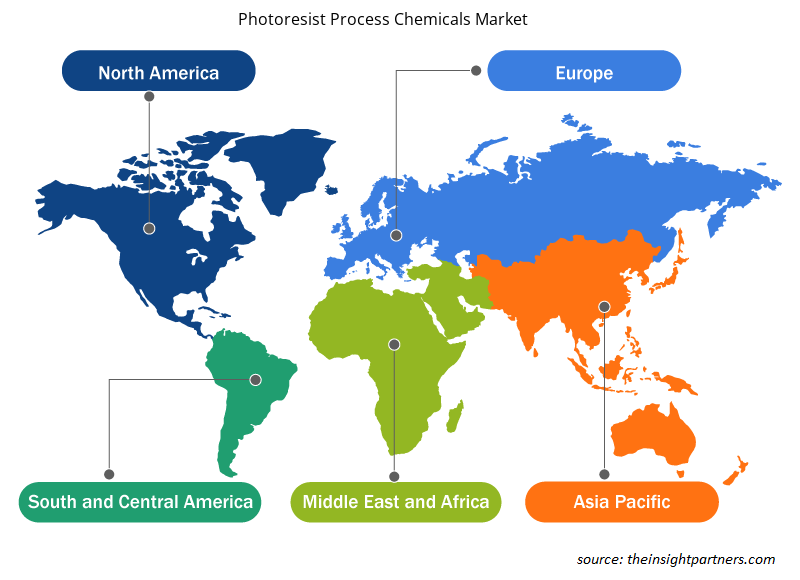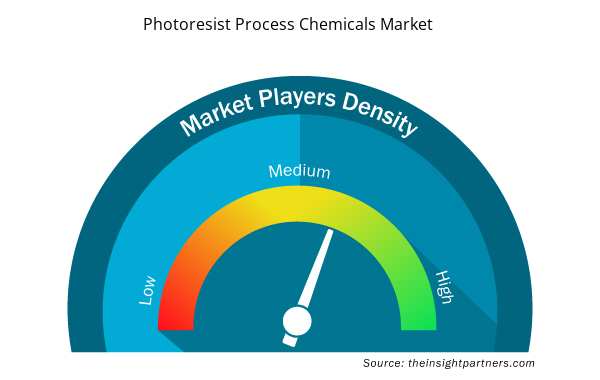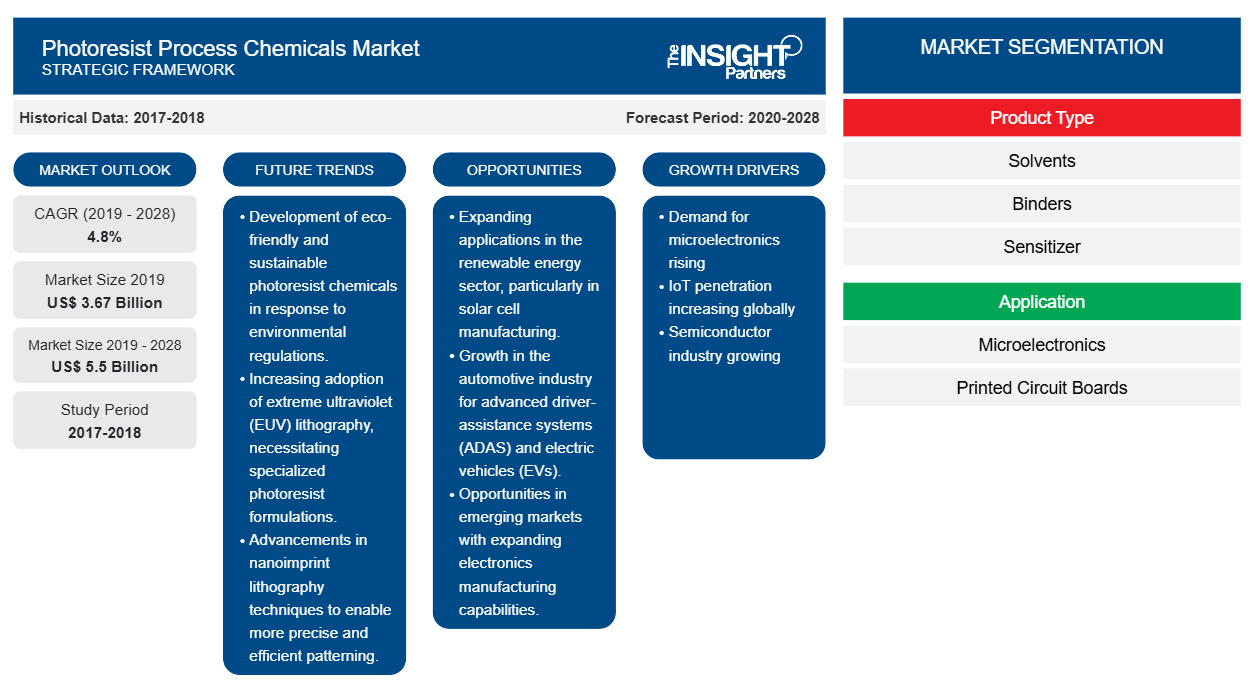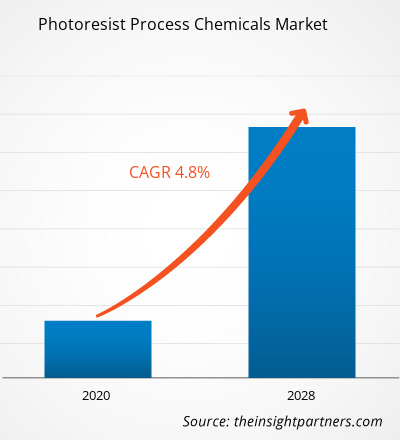Il mercato dei prodotti chimici per il processo fotoresist è stato valutato a 3.665,31 milioni di dollari nel 2019 e si prevede che crescerà a un CAGR del 4,8% nel periodo 2020-2028 per raggiungere 5.495,02 milioni di dollari entro il 2028.
I prodotti chimici di processo per fotoresist sono utilizzati nella produzione di strutture µm e sub-µm, in modo evidente nel settore della microelettronica. I prodotti chimici di processo per fotoresist comprendono solventi, sviluppatori, solventi, stripper e miscele di incisione e sono considerati una parte fondamentale per la realizzazione di circuiti stampati ad alte prestazioni e chip semiconduttori. La crescita del mercato globale dei prodotti chimici di processo per fotoresist è guidata dalla domanda continua e costante di microelettronica dovuta alla crescente domanda di articoli elettronici nei paesi in via di sviluppo e alla crescente penetrazione dell'IoT in tutto il mondo. Inoltre, fattori come la crescente domanda di tecnologia di visualizzazione dinamica e l'eccessiva R&S nei prodotti chimici di processo per fotoresist e nei settori di utilizzo finale stanno spingendo la crescita del mercato globale dei prodotti chimici di processo per fotoresist
Nel 2019, l'Asia Pacifica ha contribuito alla quota maggiore nel mercato globale dei prodotti chimici per i processi fotoresistenti. Si prevede inoltre che l'Asia Pacifica sarà il mercato in più rapida crescita per i prodotti chimici per i processi fotoresistenti nei prossimi anni. L'Asia Pacifica è il continente più grande del mondo ed è noto per il suo mercato espanso di prodotti chimici. La regione è stata notata come uno dei mercati di spicco per l'utilizzo di fotoresistenti e accessori per fotoresistenti; pertanto, offre opportunità redditizie per la crescita del mercato. La Cina sta dominando il mercato regionale, seguita da Giappone, Taiwan, Vietnam, Corea, Thailandia, Malesia e Indonesia. Questi paesi stanno riscontrando una crescente domanda da parte di semiconduttori e circuiti integrati, LCD, circuiti stampati e altri produttori. I prodotti chimici per i processi fotoresistenti sono ampiamente utilizzati nella produzione di fotoresistenti, che vengono ulteriormente utilizzati in dispositivi indossabili, smartphone e altri dispositivi elettronici. Insieme a un cambiamento negli standard di vita dei consumatori, la domanda di smartphone e dispositivi indossabili è aumentata successivamente con la crescita dell'industria elettronica. Questo cambiamento ha dato impulso alla crescita del mercato dei prodotti chimici per la lavorazione della fotoresist nella regione.
La pandemia di COVID-19 sta influenzando negativamente le economie e le industrie in vari paesi a causa di lockdown, divieti di viaggio e chiusure aziendali. Inoltre, i divieti di viaggio globali imposti dai paesi in Europa, Asia e Nord America stanno ostacolando le collaborazioni aziendali e le opportunità di partnership. Tutti questi fattori stanno ostacolando l'industria chimica e dei materiali, che sta frenando la crescita del mercato dei prodotti chimici di processo fotoresistenti.
Personalizza questo report in base alle tue esigenze
Riceverai la personalizzazione gratuita di qualsiasi report, comprese parti di questo report, o analisi a livello nazionale, pacchetto dati Excel, oltre a usufruire di grandi offerte e sconti per start-up e università
- Scopri le principali tendenze di mercato in questo rapporto.Questo campione GRATUITO includerà analisi di dati che spaziano dalle tendenze di mercato alle stime e alle previsioni.
Approfondimenti di mercato
Crescita dell'industria dei semiconduttori
I recenti progressi tecnologici hanno aumentato l'importanza dei semiconduttori in vari settori verticali dell'industria. Da componente principale dell'elettronica di consumo e delle periferiche, hanno anche assistito a un aumento della domanda da parte del settore automobilistico negli ultimi anni. Dopo aver assistito a un calo nei numeri delle vendite nel 2019, l'industria dei semiconduttori ha registrato una crescita positiva dei ricavi nel 2019 nonostante i problemi causati dalla pandemia di COVID-19 che ha portato l'economia mondiale a un arresto.
Inoltre, i semiconduttori sono un'unità integrante della tecnologia che ci circonda e rafforzano le innovazioni tecnologiche. Forniscono le tecnologie essenziali ai gadget di uso quotidiano come televisori, computer e dispositivi mobili. I prodotti chimici di processo del fotoresist sono utilizzati nella produzione di semiconduttori per la fotolitografia. La fotolitografia è stata il principale motore nella ricerca per ottenere la massima riduzione delle dimensioni di gadget e dispositivi. Per questo motivo, i prodotti chimici di processo del fotoresist hanno anche assistito a un aumento della domanda in tutto il mondo. Alcune aziende hanno anche pianificato di espandere la loro produzione di fotoresist per soddisfare la crescente domanda dell'industria dei semiconduttori. Ad esempio, a febbraio 2021, Sumitomo Chemical ha annunciato l'espansione della sua capacità produttiva di fotoresist per processi avanzati di semiconduttori, tra cui l'immersione in fluoruro di argon (ArF) e la litografia ultravioletta estrema (EUV), installando nuove linee di produzione nel suo stabilimento di Osaka (Konohana-ku, Osaka, Giappone). L'azienda prevede di avviare le operazioni entro il 2022.
Informazioni sul tipo di prodotto
In base al tipo di prodotto, il mercato globale dei prodotti chimici per il processo di fotoresist è suddiviso in solventi, leganti, sensibilizzanti e altri. Il segmento dei solventi ha guidato il mercato con la quota maggiore nel 2019. Un fotoresist è anche noto come resist ed è un'applicazione fotosensibile utilizzata in diversi processi, come la fotolitografia e la fotoincisione, principalmente per creare un rivestimento modellato su una superficie.photoresist process chemicals market is segmented into solvents, binders, sensitizer, and others. The solvents segment led the market with the largest share in 2019. A photoresist is also known as a resist, and it is a light-sensitive application utilized in several processes, such as photolithography & photoengraving, mainly to create a patterned coating on a surface.
Approfondimenti sulle applicazioni
In base all'applicazione, il mercato globale dei prodotti chimici per il processo di fotoresist è segmentato in microelettronica, circuiti stampati e altri. Nel 2019, il segmento della microelettronica ha rappresentato la quota maggiore del mercato. I dispositivi microelettronici sono costituiti da micro dispositivi semiconduttori, transistor, condensatori, resistori e chip attivi. Sono ampiamente utilizzati in apparecchi elettronici di consumo come smartphone, lettori musicali ed elettrodomestici, nonché in altri processi industriali. A questo scopo vengono utilizzati solventi fotoresist, sensibilizzanti, polimeri e altri prodotti chimici. Le crescenti applicazioni nei settori medico, automobilistico ed elettronico hanno aumentato la domanda di componenti microelettronici, il che supporta la crescita del mercato dei prodotti chimici per il processo di fotoresist.
Tokyo Ohka Kogyo Co., Ltd.; Tokuyama Corporation; Dupont; Integrated Micro Materials; Allresist Gmbh; Microchemicals Gmbh; Dischem Inc; ENF TECHNOLOGY CO., LTD.; Sumitomo Chemical Co., Ltd; e Prolyx Microelectronics Private Limited sono tra i principali attori del mercato che operano nel mercato dei prodotti chimici per i processi fotoresistenti. Queste aziende offrono i loro prodotti in tutto il mondo, il che le aiuta a soddisfare una base di clienti più ampia. Questi principali attori del mercato sono fortemente concentrati sullo sviluppo di prodotti innovativi e di alta qualità per soddisfare le esigenze del cliente. Negli ultimi anni, le aziende che operano nel mercato hanno realizzato l'immenso potenziale relativo al mercato dei prodotti chimici per i processi fotoresistenti e sono state fortemente coinvolte in strategie come fusioni e acquisizioni e lancio di prodotti. Ad esempio, nel 2019, Photoresist Stripper SVD e SH5 sono stati lanciati da Microchemicals Gmbh. Questi stripper rimuovono in modo efficiente strati di fotoresist da substrati inorganici come silicio, vetro e metalli.
Segnala i riflettori
- Tendenze industriali progressive nel mercato globale dei prodotti chimici per il processo fotoresist per aiutare gli operatori a sviluppare strategie efficaci a lungo termine
- Strategie di crescita aziendale adottate dai mercati sviluppati e in via di sviluppo
- Analisi quantitativa del mercato globale dei prodotti chimici per il processo di fotoresist dal 2018 al 2028
- Stima della domanda di prodotti chimici per il processo di fotoresist in vari settori industriali
- Analisi PEST per illustrare l'efficacia degli acquirenti e dei fornitori che operano nel settore per prevedere la crescita del mercato
- Sviluppi recenti per comprendere lo scenario competitivo del mercato e la domanda di prodotti chimici per il processo di fotoresist
- Tendenze e prospettive di mercato, insieme ai fattori che guidano e frenano la crescita del mercato dei prodotti chimici per il processo fotoresist
- Processo decisionale mediante la comprensione delle strategie che sostengono l'interesse commerciale in relazione alla crescita del mercato globale dei prodotti chimici per il processo fotoresist
- Dimensioni del mercato dei prodotti chimici per il processo di fotoresist nei vari nodi del mercato
- Panoramica dettagliata e segmentazione del mercato globale dei prodotti chimici per il processo fotoresist nonché delle sue dinamiche nel settore
- Dimensioni del mercato dei prodotti chimici per il processo di fotoresist in varie regioni con promettenti opportunità di crescita
Approfondimenti regionali sul mercato dei prodotti chimici per il processo di fotoresist
Le tendenze regionali e i fattori che influenzano il mercato dei prodotti chimici di processo per fotoresist durante il periodo di previsione sono stati ampiamente spiegati dagli analisti di Insight Partners. Questa sezione discute anche i segmenti e la geografia del mercato dei prodotti chimici di processo per fotoresist in Nord America, Europa, Asia Pacifico, Medio Oriente e Africa e Sud e Centro America.

- Ottieni i dati specifici regionali per il mercato dei prodotti chimici per il processo di fotoresist
Ambito del rapporto di mercato sui prodotti chimici di processo fotoresistenti
| Attributo del report | Dettagli |
|---|---|
| Dimensioni del mercato nel 2019 | 3,67 miliardi di dollari USA |
| Dimensioni del mercato entro il 2028 | 5,5 miliardi di dollari USA |
| CAGR globale (2019 - 2028) | 4,8% |
| Dati storici | 2017-2018 |
| Periodo di previsione | 2020-2028 |
| Segmenti coperti | Per tipo di prodotto
|
| Regioni e Paesi coperti | America del Nord
|
| Leader di mercato e profili aziendali chiave |
|
Attori del mercato dei prodotti chimici per il processo di fotoresist Densità: comprendere il suo impatto sulle dinamiche aziendali
Il mercato dei prodotti chimici per processi fotoresistenti sta crescendo rapidamente, spinto dalla crescente domanda degli utenti finali dovuta a fattori quali l'evoluzione delle preferenze dei consumatori, i progressi tecnologici e una maggiore consapevolezza dei vantaggi del prodotto. Con l'aumento della domanda, le aziende stanno ampliando le loro offerte, innovando per soddisfare le esigenze dei consumatori e capitalizzando sulle tendenze emergenti, il che alimenta ulteriormente la crescita del mercato.
La densità degli operatori di mercato si riferisce alla distribuzione di aziende o società che operano in un particolare mercato o settore. Indica quanti concorrenti (operatori di mercato) sono presenti in un dato spazio di mercato in relazione alle sue dimensioni o al valore di mercato totale.
Le principali aziende che operano nel mercato dei prodotti chimici per il processo fotoresist sono:
- Società per azioni Tokyo Ohka Kogyo Co., Ltd.
- Società Tokuyama
- Dupont
- Micro Materiali Integrati
- Allresist GmbH
Disclaimer : le aziende elencate sopra non sono classificate secondo un ordine particolare.

- Ottieni una panoramica dei principali attori del mercato dei prodotti chimici per il processo fotoresist
Mercato dei prodotti chimici per il processo di fotoresist, per tipo di prodotto
- Solventi
- Leganti
- Sensibilizzante
- Altri
Mercato dei prodotti chimici per il processo di fotoresist, per applicazione
- Microelettronica
- Circuiti stampati
- Altri
Profili aziendali
- Società per azioni Tokyo Ohka Kogyo Co., Ltd.
- Società Tokuyama
- Dupont
- Micro Materiali Integrati
- Allresist GmbH
- Microchimica GmbH
- Dischem Inc
- ENF TECHNOLOGY CO., LTD.
- Società chimica Sumitomo, Ltd.
- Prolyx Microelettronica privata a responsabilità limitata
- Analisi storica (2 anni), anno base, previsione (7 anni) con CAGR
- Analisi PEST e SWOT
- Valore/volume delle dimensioni del mercato - Globale, regionale, nazionale
- Industria e panorama competitivo
- Set di dati Excel



Report Coverage
Revenue forecast, Company Analysis, Industry landscape, Growth factors, and Trends

Segment Covered
This text is related
to segments covered.

Regional Scope
North America, Europe, Asia Pacific, Middle East & Africa, South & Central America

Country Scope
This text is related
to country scope.
Domande frequenti
In 2019, microelectronics segment accounted for a larger share of the global photoresist process chemicals market. Microelectronics field consist of micro semiconductor devices transistors, capacitors, and resistors an active chip. They are widely being used in consumer electronics such as smartphones, music players, household appliances, etc. and in other industrial processes. Microelectronic components need protection from the environment, also both electrical & mechanical connections to the surrounding components. Photoresist solvent, sensitizers, polymers, and other chemicals are used for this purpose. Growing applications in medical, automotive, and electronic industries has raised the demand for microelectronic components which supports the growth of photoresist process chemicals market.
The major players operating in the global photoresist process chemicals market are Tokyo Ohka Kogyo Co., Ltd., Tokuyama Corporation, Dupont, Integrated Micro Materials, Allresist Gmbh, Microchemicals Gmbh, Dischem Inc, Enf Technology Co., Ltd., Sumitomo Chemical Co., Ltd, Prolyx Microelectronics Private Limited and among others.
In 2019, the photoresist process chemicals market was dominated by Asia Pacific region at the global level. The demand for smartphones and wearable devices has increased subsequently with the growth of the electronics industry, along with a shift in consumer living standards. This shift has influenced the growth of the market in the region. The growing consciousness among the consumers about the connected world on devices with IoT favors the growth of the market. Furthermore, rising purchasing capabilities and expanding disposable income are estimated to favor market growth.
Trends and growth analysis reports related to Chemicals and Materials : READ MORE..
The List of Companies - Photoresist Process Chemicals Market
- Tokyo Ohka Kogyo Co., Ltd.
- Tokuyama Corporation
- Dupont
- Integrated Micro Materials
- Allresist Gmbh
- Microchemicals Gmbh
- Dischem Inc
- ENF TECHNOLOGY CO., LTD.
- Sumitomo Chemical Co., Ltd
- Prolyx Microelectronics Private Limited
The Insight Partners performs research in 4 major stages: Data Collection & Secondary Research, Primary Research, Data Analysis and Data Triangulation & Final Review.
- Data Collection and Secondary Research:
As a market research and consulting firm operating from a decade, we have published and advised several client across the globe. First step for any study will start with an assessment of currently available data and insights from existing reports. Further, historical and current market information is collected from Investor Presentations, Annual Reports, SEC Filings, etc., and other information related to company’s performance and market positioning are gathered from Paid Databases (Factiva, Hoovers, and Reuters) and various other publications available in public domain.
Several associations trade associates, technical forums, institutes, societies and organization are accessed to gain technical as well as market related insights through their publications such as research papers, blogs and press releases related to the studies are referred to get cues about the market. Further, white papers, journals, magazines, and other news articles published in last 3 years are scrutinized and analyzed to understand the current market trends.
- Primary Research:
The primarily interview analysis comprise of data obtained from industry participants interview and answers to survey questions gathered by in-house primary team.
For primary research, interviews are conducted with industry experts/CEOs/Marketing Managers/VPs/Subject Matter Experts from both demand and supply side to get a 360-degree view of the market. The primary team conducts several interviews based on the complexity of the markets to understand the various market trends and dynamics which makes research more credible and precise.
A typical research interview fulfils the following functions:
- Provides first-hand information on the market size, market trends, growth trends, competitive landscape, and outlook
- Validates and strengthens in-house secondary research findings
- Develops the analysis team’s expertise and market understanding
Primary research involves email interactions and telephone interviews for each market, category, segment, and sub-segment across geographies. The participants who typically take part in such a process include, but are not limited to:
- Industry participants: VPs, business development managers, market intelligence managers and national sales managers
- Outside experts: Valuation experts, research analysts and key opinion leaders specializing in the electronics and semiconductor industry.
Below is the breakup of our primary respondents by company, designation, and region:

Once we receive the confirmation from primary research sources or primary respondents, we finalize the base year market estimation and forecast the data as per the macroeconomic and microeconomic factors assessed during data collection.
- Data Analysis:
Once data is validated through both secondary as well as primary respondents, we finalize the market estimations by hypothesis formulation and factor analysis at regional and country level.
- Macro-Economic Factor Analysis:
We analyse macroeconomic indicators such the gross domestic product (GDP), increase in the demand for goods and services across industries, technological advancement, regional economic growth, governmental policies, the influence of COVID-19, PEST analysis, and other aspects. This analysis aids in setting benchmarks for various nations/regions and approximating market splits. Additionally, the general trend of the aforementioned components aid in determining the market's development possibilities.
- Country Level Data:
Various factors that are especially aligned to the country are taken into account to determine the market size for a certain area and country, including the presence of vendors, such as headquarters and offices, the country's GDP, demand patterns, and industry growth. To comprehend the market dynamics for the nation, a number of growth variables, inhibitors, application areas, and current market trends are researched. The aforementioned elements aid in determining the country's overall market's growth potential.
- Company Profile:
The “Table of Contents” is formulated by listing and analyzing more than 25 - 30 companies operating in the market ecosystem across geographies. However, we profile only 10 companies as a standard practice in our syndicate reports. These 10 companies comprise leading, emerging, and regional players. Nonetheless, our analysis is not restricted to the 10 listed companies, we also analyze other companies present in the market to develop a holistic view and understand the prevailing trends. The “Company Profiles” section in the report covers key facts, business description, products & services, financial information, SWOT analysis, and key developments. The financial information presented is extracted from the annual reports and official documents of the publicly listed companies. Upon collecting the information for the sections of respective companies, we verify them via various primary sources and then compile the data in respective company profiles. The company level information helps us in deriving the base number as well as in forecasting the market size.
- Developing Base Number:
Aggregation of sales statistics (2020-2022) and macro-economic factor, and other secondary and primary research insights are utilized to arrive at base number and related market shares for 2022. The data gaps are identified in this step and relevant market data is analyzed, collected from paid primary interviews or databases. On finalizing the base year market size, forecasts are developed on the basis of macro-economic, industry and market growth factors and company level analysis.
- Data Triangulation and Final Review:
The market findings and base year market size calculations are validated from supply as well as demand side. Demand side validations are based on macro-economic factor analysis and benchmarks for respective regions and countries. In case of supply side validations, revenues of major companies are estimated (in case not available) based on industry benchmark, approximate number of employees, product portfolio, and primary interviews revenues are gathered. Further revenue from target product/service segment is assessed to avoid overshooting of market statistics. In case of heavy deviations between supply and demand side values, all thes steps are repeated to achieve synchronization.
We follow an iterative model, wherein we share our research findings with Subject Matter Experts (SME’s) and Key Opinion Leaders (KOLs) until consensus view of the market is not formulated – this model negates any drastic deviation in the opinions of experts. Only validated and universally acceptable research findings are quoted in our reports.
We have important check points that we use to validate our research findings – which we call – data triangulation, where we validate the information, we generate from secondary sources with primary interviews and then we re-validate with our internal data bases and Subject matter experts. This comprehensive model enables us to deliver high quality, reliable data in shortest possible time.


 Ottieni un campione gratuito per questo repot
Ottieni un campione gratuito per questo repot